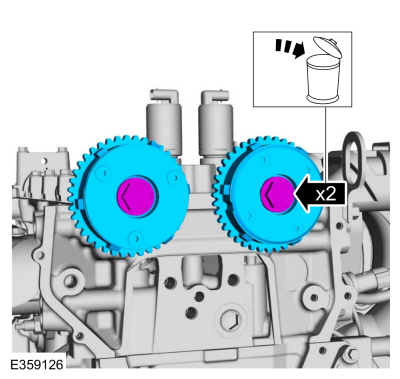Ford Ecosport: Fuel Charging and Controls - 2.0L Duratec-HE (129kW/175PS) / Diagnosis and Testing - High-Pressure Fuel System
Ford Ecosport 2014-2025 Service and Repair Manual / Engine / Fuel Charging and Controls - 2.0L Duratec-HE (129kW/175PS) / Diagnosis and Testing - High-Pressure Fuel System
Diagnostic Trouble Code (DTC) Chart
Diagnostics in this manual assume a certain skill level and knowledge of Ford-specific diagnostic practices.
REFER to: Diagnostic Methods (100-00 General Information, Description and Operation).
| Module | DTC | Description | Action |
|---|---|---|---|
| PCM | P0001:00 | Fuel Volume Regulator 'A' Control Circuit/Open: No Sub Type Information | GO to Pinpoint Test HP |
| PCM | P0003:00 | Fuel Volume Regulator 'A' Control Circuit Low: No Sub Type Information | GO to Pinpoint Test HP |
| PCM | P0004:00 | Fuel Volume Regulator 'A' Control Circuit High: No Sub Type Information | GO to Pinpoint Test HP |
| PCM | P0087:00 | Fuel Rail/System Pressure - Too Low (Bank 1): No Sub Type Information | GO to Pinpoint Test HP |
| PCM | P0088:00 | Fuel Rail/System Pressure - Too High (Bank 1): No Sub Type Information | GO to Pinpoint Test HP |
| PCM | P00C6:00 | Fuel Rail Pressure Too Low - Engine Cranking (Bank 1): No Sub Type Information | GO to Pinpoint Test HP |
| PCM | P053F:00 | Cold Start Fuel Pressure Performance Bank 1: No Sub Type Information | GO to Pinpoint Test HP |
Global Customer Symptom Code (GCSC) Chart
Diagnostics in this manual assume a certain skill level and knowledge of Ford-specific diagnostic practices.
REFER to: Diagnostic Methods (100-00 General Information, Description and Operation).
| Symptom | Action |
|---|---|
| Start/Run/Move > Running > Smoke From Exhaust > Black | GO to Pinpoint Test HP |
| Driving Performance > Stalls/Quits > At Idle > Always | GO to Pinpoint Test HP |
| Driving Performance > Poor Fuel Economy > Combined > Unloaded | GO to Pinpoint Test HP |
Pinpoint Tests
 PINPOINT TEST HP: HIGH PRESSURE FUEL DELIVERY SYSTEM
PINPOINT TEST HP: HIGH PRESSURE FUEL DELIVERY SYSTEM
 Introduction Introduction
NOTICE: Do not apply battery voltage across the fuel injection pump circuits. Damage to the fuel volume regulator solenoid may result. Normal Operation and Fault Conditions Refer to the DTC Fault Trigger Conditions. DTC Fault Trigger Conditions
Possible Sources
|
 Diagnosis and Testing - Fuel Control
Diagnosis and Testing - Fuel Control
Diagnostic Trouble Code (DTC) Chart
Diagnostics in this manual assume a certain skill level and knowledge of Ford-specific diagnostic practices.REFER to: Diagnostic Methods (100-00 General Information, Description and Operation)...
 Removal and Installation - Fuel Injectors
Removal and Installation - Fuel Injectors
Removal and Installation
The fuel injectors are removed with the fuel rail.
Refer to: Fuel Rail (303-04C Fuel Charging and Controls - 2.0L Duratec-HE (129kW/175PS), Removal and Installation)...
Other information:
Ford Ecosport 2014-2025 Service and Repair Manual: Removal and Installation - Front Fender Moulding
Removal NOTE: Removal steps in this procedure may contain installation details. NOTE: LH side shown, RH side similar. With the vehicle in NEUTRAL, position it on a hoist. Refer to: Jacking and Lifting - Overview (100-02 Jacking and Lifting, Description and Operation)...
Ford Ecosport 2014-2025 Service and Repair Manual: Description and Operation - Horn - System Operation and Component Description
System Operation System Diagram Item Description 1 LH Horn 2 RH Horn 3 Horn Relay 4 BCM 5 Clockspring 6 Horn Switch Horn Operation The horn switch consists of 2 sets of contacts separated by springs...
Copyright © 2025 www.foecosport2.com

 PINPOINT TEST HP: HIGH PRESSURE FUEL DELIVERY SYSTEM
PINPOINT TEST HP: HIGH PRESSURE FUEL DELIVERY SYSTEM

 Introduction
Introduction
